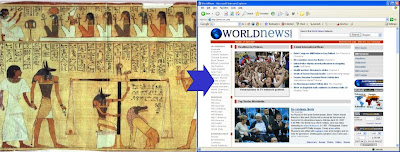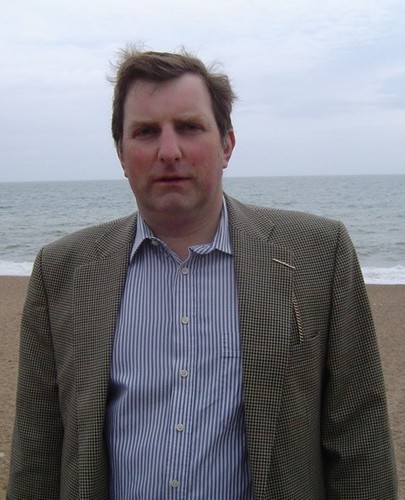It is usual to think of human development as being very slow until recently, when it suddenly took off. Here is a typical quote, from the British sociologist Anthony Giddens, relying on the American political scientist John H Kautsky:
...it is the 'relatively overwhelming absence of major social and economic
change' that characterizes the variant forms of society that existed across the
face of world history until some two or three centuries ago.
(Giddens The constitution of society p. 199)
When one thinks of the inventions of the last one or two hundred years--radio, the internal combustion engine, heavier-than-air flight, spaceflight, computers and the internet--it certainly looks as though many dramatic innovations have occurred in a very short time. Compared to the 30,000 years of the upper paleolithic, when people continued to live by hunting and gathering, the twentieth century seems to have been characterised by dizzying change.
One can also predict this on theoretical grounds. The more people on the planet, and the more technology there already is, the faster we might expect inventions to come.
Yet how should we measure the significance of an invention?
Which was more revolutionary: the invention of the typewriter or the invention of writing? There is a case for saying that the change from a world without writing to a world with writing was more fundamental than the mere technical improvement represented by the typewriter. The word processor is another (impressive) improvement within a long list of improvements affecting writing, such as paper, ink and moveable type, but neither it nor any of these is as revolutionary in its implications as the invention of literacy itself. The word processor is a great boon, but it is just a better way of producing letters and reports. It has not transformed society that much, if we remember that people still managed to organise such things as the Normandy landings or the Apollo programme without it.
The internet, too, could be seen as just another incremental improvement in information technology, building on the original invention of writing. In other words, in this important area of life, the really dramatic change occurred some five thousand years ago. Everything since has been by way of refinement only.

The invention of writing was revolutionary. Everything since can be seen as a technical improvement in the ability to prepare and disseminate written information.
In ancient times, people were already writing letters and books. Through letters, people could carry on conversations when they were physically separated. Through books, people became exposed to ideas and participated in a far-flung intellectual community. What are email and the world wide web but just better ways of achieving the same thing?
All we are seeing today are the latest twists in a long process of getting more information, more quickly to more people. Ever since the invention of writing, there has been almost continual improvement, both technological and institutional. For instance, communications could be improved by better transport or cheaper writing materials, and these could result from technical innovations as well as from the efforts of politicians and entrepreneurs in setting up factories and commercial networks. To give a couple of examples:
In Roman times, communications were improved not only by the building of roads but by the cursus publicus (public mail), which was initially set up for governmental purposes but was also used by private persons. A system of relay stations, where horses were changed, allowed mail to be carried over hundreds of miles at the rate of a horse's gallop.
In eighteenth century Britain, communications improved as tarmac and sprung carriages enhanced the speed and ease of road transport. A network of stage coaches was set up, distributing mail throughout the country.
One might also mention things like the postage stamp and the fountain pen, as well as the continuous evolution of printing since the days of Gutenburg and Caxton. A list of all the inventions and improvements that have advanced information technology would be enormous and would show that in every period, not just in recent times, people might have perceived themselves to be living amidst great changes.
An effect of the internet has been a 'democratisation' of information flow. Blogging allows anyone to publish their opinions, and through blogs we are exposed to alternative narratives beyond those of the 'mainstream media'. We need not believe everything we read, but sceptical commentary ('conspiracy theory') surrounding events such as 9/11 alerts us to possibilities that mainstream channels might wish to conceal. We can take a more intelligent view of what we are being told and it is seemingly harder for the authorities to deceive and control their populations. This feels like a revolutionary social change, but such democratisation has always been an accompaniment of improving information technology. It is said that the introduction of printing loosened the hold of the church over what was published, and helped stimulate the Christian Reformation. The first newspapers and journals in the eighteenth century would have seemed as excitingly subversive as blogs do today, and like blogging they were made possible by technological improvements, in this case to do with better printing presses and the distribution networks created by the stagecoach.
If we think of truly revolutionary inventions--those that are not just an improvement to an existing technique but stand themselves at the beginning of a long process of improvement--they might be more evenly distributed throughout history than we appreciate. Things like agriculture and metal-working were enormously transforming in their day, and unleashed tremendous potential for the future progress of the human race. How can we seriously think of the first generations to farm the land or to cast bronze and still agree with the above quotation that 'social and economic change' was 'overwhelmingly absent' until recent times.

Revolutionary, transforming innovations have occurred throughout history, and the more recent innovations are not necessarily more significant than those of the past.
If things that initially seem revolutionary like word processing and printing can be seen as incremental improvements, then what seem to us like small changes in, say, the design of stone tools might have seemed quite revolutionary when they were made. To us stone tools are just stone tools, but to people who knew nothing else subtle variations would have been important, and perhaps made as much difference to their way of life as the move from typewriters to word processing has made to the task of running a business today. In the same way, what seem to us like big changes, such as the introduction of the internal combustion engine, may seem like trivial improvements to people in the far future--yes, we have dispensed with the horse but otherwise we are still crudely travelling around in four-wheeled vehicles along streets and roads on the planet's surface. When people are zipping from galaxy to galaxy by some form of matter transportation, the difference between a motor-car and a horse-and-cart will not seem that great.
Those fundamental inventions that were made long ago, such as farming, writing and metal-working, did not come entirely out of the blue (I will deal with this in a later post). Nevertheless, insofar as their inventors had fewer models to go on than inventors do today, their achievement might be seen as all the greater. Something like the sewing needle has barely changed since it was invented 30,000 years ago. It was brought to perfection by people living in paleolithic times, and yet it remains a vital component of our technology (I thank my sister for this example).
I do not want to turn things on their head and argue that it was the stone age people who were the real innovators. What I do want to point out is that innovation and change have been part of human experience from the beginning, and the idea that things have dramatically sped up in our own time is a matter of subjective perception as much as objective fact.



